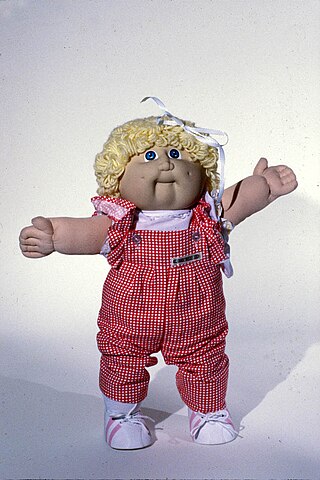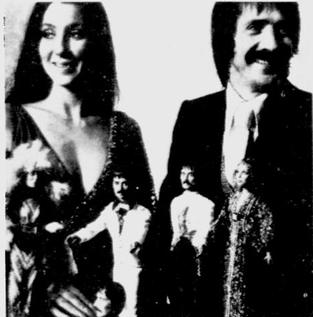
Cabbage Kids are a line of cloth dolls with plastic heads first produced by Coleco Industries in 1982. They were inspired by the Little People soft sculptured dolls sold by Xavier Roberts as collectibles. The brand was renamed 'Cabbage Kids' by Roger L. Schlaifer when he acquired the exclusive worldwide licensing rights in 1982.

Barbie is a fashion doll manufactured by American toy company Mattel, Inc. and launched on March 9, 1959. American businesswoman Ruth Handler is credited with the creation of the doll using a German doll called Bild Lilli as her inspiration.

A doll is a model typically of a human or humanoid character, often used as a toy for children. Dolls have also been used in traditional religious rituals throughout the world. Traditional dolls made of materials such as clay and wood are found in the Americas, Asia, Africa and Europe. The earliest documented dolls go back to the ancient civilizations of Egypt, Greece, and Rome. They have been made as crude, rudimentary playthings as well as elaborate art. Modern doll manufacturing has its roots in Germany, from the 15th century. With industrialization and new materials such as porcelain and plastic, dolls were increasingly mass-produced. During the 20th century, dolls became increasingly popular as collectibles.

An action figure is a poseable character model figure made most commonly of plastic, and often based upon characters from a film, comic book, military, video game or television program; fictional or historical. These figures are usually marketed toward boys and adult collectors. The term was coined by Hasbro in 1964 to market G.I. Joe to boys.
The Mego Corporation was an American toy company that in its original iteration was first founded in 1954. Originally known as a purveyor of dime store toys, in 1971 the company shifted direction and became famous for producing licensed dolls, celebrity dolls, and the Micronauts toy line. For a time in the 1970s, their line of 8-inch-scale action figures with interchangeable bodies became the industry standard.
Kenner Products, known simply as Kenner, was an American toy company founded in 1946. Throughout its history, the Kenner brand produced several highly recognizable toys and merchandise lines including action figures like the original series of Star Wars, Jurassic Park and Batman as well as die cast models. The company was closed by its corporate parent Hasbro in 2000.

Blythe is a fashion doll, about 28 cm (11 inch) tall, with an oversized head and large eyes that change color with the pull of a string. It was created in 1972 and was initially only sold for one year in the United States by toy company Kenner. In 2001 the Japanese toy company Takara began producing new editions of Blythe dolls. There is a network of hobbyists who customize the doll for resale and create clothing and shoes for Blythe. Enthusiasts share photographs of their work and other types of dolls on the Internet.
Denise Holly Hobbie is an American writer, watercolorist and illustrator. Holly Hobbie is also the name of a fictional character she created.

Polly Pocket is a toy line of dolls and accessories first founded and designed by Chris Wiggs in 1983 and licensed by Bluebird Toys from 1989 until both entities/properties were acquired by Mattel in 1998.
Totally Hair Barbie is a fashion doll in the Barbie line that was released in 1992. The doll's extra-long hair reached all the way to her toes and at the time, she had the longest hair ever for a Barbie doll. She is notable for being the highest selling Barbie doll in history.

Fashion dolls are dolls primarily designed to be dressed to reflect fashion trends. They are manufactured both as toys for children to play with and as collectibles for adults. The dolls are usually modeled after teen girls or adult women, though child, male, and even some non-human variants exist. Contemporary fashion dolls are typically made of vinyl or another plastic.

Littlest Pet Shop is a toy franchise and cartoon series owned by Hasbro. The original toy series was produced by Kenner in the early 1990s. An animated television series was made in 1995 by Sunbow Productions and Jean Chalopin Creativite et Developpement, based on the franchise.

Ideal Toy Company was an American toy company founded by Morris Michtom and his wife, Rose. During the post–World War II baby boom era, Ideal became the largest doll-making company in the United States. Their most popular dolls included Betsy Wetsy, Toni, Saucy Walker, Shirley Temple, Miss Revlon, Patti Playpal, Tammy, Thumbelina, Tiny Thumbelina, and Crissy. The company is also known for selling the Rubik's Cube.

Earring Magic Ken is a model of the Ken doll introduced by Mattel in 1993 as a companion to its Earring Magic Barbie figure, one of six dolls in the Earring Magic Barbie line. This generation of the Ken doll featured an updated look, including blond highlights in his traditionally brown hair, outfits including lavender mesh shirt, purple pleather vest, a necklace with a circular charm and, as the name indicates, an earring in his left ear.

The Sonny & Cher dolls were a collection of 12-¼ inch high celebrity doll likenesses of pop rock duo Sonny & Cher. The line was released by Mego Corporation in 1976. The release of these fashion dolls coincided with the popularity of The Sonny & Cher Show prime time variety TV show.
Wee 3 is a Canadian preschool television series aired on Treehouse TV and Radio-Canada. It first aired on January 30, 2001 with a total of 27 27-minute episodes, along with Treetown, Ants in Your Pants and Crazy Quilt. It also formerly aired as an acquired series on YTV.
The Barbie Basics is a line of collector's edition Barbie dolls. They were created by Mattel designer Bill Greening and were introduced in late 2009 to be officially released in the spring of 2010.

Ever After High is a fashion doll franchise released by Mattel in July 2013. It is a companion line to the Monster High dolls, with the characters being based upon characters from well-known fairy tales and fantasy stories instead of monsters and mythical creatures. As with Monster High and Barbie: Life in the Dreamhouse, the line varies in different countries and varies in languages. It has spawned a web series, a film, and a five book series.

Barbie Dolphin Magic or Barbie: Dolphin Magic is a 2017 computer-animated adventure television film directed by Conrad Helten and written by Jennifer Skelly.













